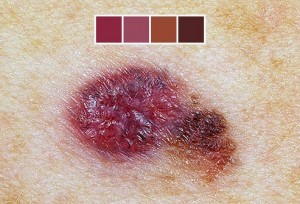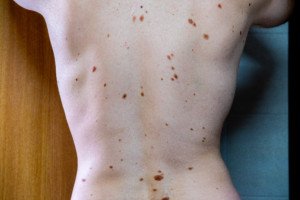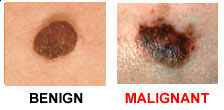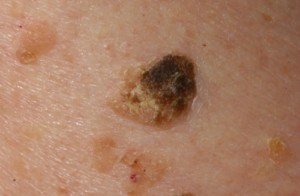
Every question you can have about moles and melanoma is answered right here, because I was fed up with years of seeing the same generic and vague information about moles and melanoma.
My questions were directed to Jason R. Lupton, MD, board certified dermatologist practicing in the San Diego, CA area.
A mole that is melanoma can sometimes itch.
Can it itch and still look the same as it always has? Or will an itching cancerous mole always look like it’s changing?
Dr. Lupton: A mole that itches may not always look like it’s changing.
Is mole itching from melanoma subtle and/or really annoying? Is it necessarily every day?
Itching associated with a melanoma can vary — it will not necessarily itch all the time. It may be subtle itching or may be quite pronounced.
It’s said that a risk factor for melanoma is a mole that stands out or looks different from others.

Atypical moles. Shutterstock/Mikel Ugarte Gil
But what if it has always been this way? Does the relative “differentness” in and of itself mean the mole is more likely to become malignant?
If a mole looks very different from others then I usually biopsy that one.
If a patient comes in for a skin check and one mole looks very different or atypical than the others, then often I will biopsy that mole to see how it looks microscopically.
A different-appearing mole may not necessarily be a bad mole — but it should be evaluated.
What makes a mole look “different” is the comparison of it to others.
Suppose a mole on someone’s calf looks different than all his others, but the calf mole has always looked the same.
What would be the significance if, in a parallel universe, this same person had only one mole on his entire body, on the calf, and thus, the concept of this mole looking different from others wouldn’t be applicable?
Often people have the same types of moles. That is, some people have many moles that have some redness to them, or that are all very dark, or that are brown and black, etc.
When doing a skin exam it is important to assess the types of moles someone has and what differences, if any, there are among them.
It is all done on a case by case basis – unfortunately, there are no rules to follow regarding this. If a mole looks different than the others then it may need a biopsy.
It all depends on whether that mole just looks different or if it also looks irregular or atypical — meaning irregular colors, border, size, recent changes, etc.

Is a certain type of mole more likely to become melanoma, other than ones bigger than 5 millimeters?
That is, dark moles, light moles, raised moles, oblong moles, ones with a hair, two-toned moles?
No — not really. Any mole can become a melanoma. Larger moles may have an increased risk — especially very large lesions.
Other than that, any spot on the skin can become cancerous — whether it is dark or light.
There is a type of melanoma — the amelanotic melanoma — that is particularly scary because it does not have the classic dark, changing colors most people associate with a “bad” mole.

amelanotic melanoma
These can look like pink or light red or even flesh colored skin lesions — often patients are not worried or concerned about these.
We always read about changes to look for in moles.
But most melanoma occurs absent moles, so what else should we look for on skin in general, that might mean the deadliest skin cancer?
Over the past 25 years, the same handful of melanoma photos have appeared in magazines, pamphlets and the Internet.
They appear to have sprung from pre-existing moles, rather than just plain skin.
Any new lesion should be evaluated. A melanoma may arise anywhere on the skin — even the palms or soles of the feet or in the groin area. Any new lesion that is changing in any way should be evaluated by a dermatologist.
A melanoma will not remain static — it will continue to change and grow over time.
Why does melanoma get past so many people? 1) They don’t see it due to its location, 2) They see it changing but are in denial? Or 3) They don’t know about the warning signs of skin cancer despite all the media attention, and, though they are aware of the changing lesion, don’t think anything of it.
I think all three! Many people are not in tune with their moles and do not get regular screening exams.

Shutterstock/Image Point Fr
Also, if someone sees something changing they often have an alternate explanation for it — there is sometimes that element of denial — that a melanoma cannot happen to them.
Does a melanoma in a pre-existing mole always look suspicious? I realize that the first day the mole becomes melanoma, there is no way the naked eye could detect this.
But for how long can a mole have this deadly cancer before a person can see something suspicious?
This is unknown — some are more aggressive than others. A lesion may progress to a cancerous lesion and not be detectable for months or longer. It is really unknown.
If a mole changes colors from melanoma, will it necessarily also be getting bigger simultaneously, or changing in some other way concurrently?
Or if it gets bigger from melanoma, will it also necessarily be changing color?
A melanoma will often have changes — color and size. The initial changes may be subtle, so only one may be noticed at first, but if left over time, then a change in size is almost always seen.
How often can melanoma arise out of a very tiny mole, i.e., a birthmark?
After all, every skin cancer warning list mentions moles the size of a pencil eraser as being possible signs of melanoma.
The rules regarding melanoma are certainly not absolutes. A melanoma can be very small — not always bigger than a pencil eraser (as an aside I just discovered a melanoma on one of my patients last week — on her arm … it was only about 3 mm in diameter but was half brown and half red, so I biopsied it and it turned out to be a melanoma).
I think the important thing here is the guidelines are helpful, but you can’t be too tied to them.
If a lesion looks suspicious it should be biopsied — and everyone should have a yearly skin exam by a dermatologist to be safe.
Suppose a person magically knows that soon, he’ll develop a melanoma on a non-mole area of skin. He watches that area every day.
At some point, a malignant spot will become visible, when the day prior, it was not detectable.
So if this person watches his skin every day in that exact spot, how big will the melanoma be when he first sees it?
That is, could a malignant spot appear over night that’s 2 millimeters?
Or how big would it be from one non-detectable day to the next detectable day?
This is unknown — but my guess would be it would be a very small spot at first and then develop a more prominent lesion over time depending upon how long it’s left.

Stages of melanoma. Cancer Research UK
Can melanoma change visibly from month to month?
Week to week? What is the fastest a mole can change visibly to the naked eye?
In other words, suppose a person suspects skin cancer and thus watched the spot carefully.
If after two months, it looks the same, can the person assume it can’t be malignant? How about one month?
Good question. I usually tell my patients to watch their moles about every three months or so — to take an all-over look then … if you look too often you won’t notice subtle changes, but if you wait too long you may miss something.
There is no ideal rule — a melanoma can develop at any time and if something CONTINUES to change then it should be looked at by a dermatologist.
It also depends upon the type of lesion, the age of the patient, the body location, etc. So I can’t give an absolute on this one.
What skin conditions can really look like melanoma?
Birthmarks, normal moles, seborrheic keratoses, pyogenic granulomas, vascular lesions, dermatofibromas, dysplastic nevi (atypical moles), etc.

Seborrheic keratosis
It’s said that if caught early, 95 percent, 97 percent, or “near 100 percent” of melanoma can be cured.
Why not 100 percent? What happens in those 5 percent of patients that they die despite an early catch?
The early catch may not really be early — there may be micro-metastases or microscopic lymph node involvement that cannot be detected by current technologies.
It makes absolutely no sense that the human body didn’t evolve to have a stronger defense against the sun’s damaging rays.
Early man, including pale-skinned ancient Europeans, spent tremendous amounts of time in the sun.
It only makes sense that we all should have a built-in guard against skin cancer.
So why all the skin cancer in modern man, who spends less time in the sun than ancient man? Even modern-day sunbathers aren’t in the sun as much as primitive man.
I think it also has a lot to do with the depletion in the ozone layer, and with modern man there is limited sun exposure at times coupled with more intense periods … these episodic sun exposures may be associated with increased risks of skin cancer development.

 Dr. Lupton
Dr. Lupton









